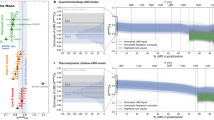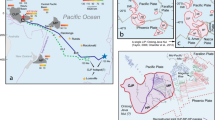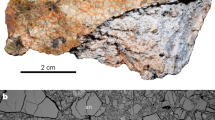Abstract
Chemical evolution of planetary bodies, ranging from asteroids to the large rocky planets, is thought to begin with differentiation through solidification of magma oceans many hundreds of kilometres in depth1,2,3. The Earth’s Moon is the archetypical example of this type of differentiation. Evidence for a lunar magma ocean is derived largely from the widespread distribution, compositional and mineralogical characteristics, and ancient ages inferred for the ferroan anorthosite (FAN) suite of lunar crustal rocks. The FANs are considered to be primary lunar flotation-cumulate crust that crystallized in the latter stages of magma ocean solidification. According to this theory, FANs represent the oldest lunar crustal rock type2,3,4. Attempts to date this rock suite have yielded ambiguous results, however, because individual isochron measurements are typically incompatible with the geochemical make-up of the samples, and have not been confirmed by additional isotopic systems5,6,7,8,9. By making improvements to the standard isotopic techniques, we report here the age of crystallization of FAN 60025 using the 207Pb–206Pb, 147Sm–143Nd and 146Sm–142Nd isotopic systems to be 4,360 ± 3 million years. This extraordinarily young age requires that either the Moon solidified significantly later than most previous estimates or the long-held assumption that FANs are flotation cumulates of a primordial magma ocean is incorrect. If the latter is correct, then much of the lunar crust may have been produced by non-magma-ocean processes, such as serial magmatism10.
This is a preview of subscription content, access via your institution
Access options
Subscribe to this journal
Receive 51 print issues and online access
$199.00 per year
only $3.90 per issue
Buy this article
- Purchase on Springer Link
- Instant access to full article PDF
Prices may be subject to local taxes which are calculated during checkout



Similar content being viewed by others
References
Lapen, T. J. et al. A younger age for ALH84001 and its geochemical link to shergottite sources in Mars. Science 328, 347–351 (2010)
Wood, J. A., Dickey, J. S., Marvin, U. B. & Powell, B. N. Lunar anorthosites and a geophysical model of the moon. Proc. Lunar Planet. Sci Conf. I, 965 (1970)
Smith, J. A. et al. Petrologic history of the Moon inferred from petrography, mineralogy, and petrogenesis of Apollo 11 rocks. Proc. Lunar Planet. Sci Conf. I, 1, 149 (1970)
Snyder, G. A., Taylor, L. A. & Neal, C. R. A chemical model for generating the source of mare basalts: combined equilibrium and fractional crystallization of the lunar magmasphere. Geochim. Cosmochim. Acta 56, 3809–3823 (1992)
Carlson, R. W. & Lugmair, G. W. The age of ferroan anorthosite 60025: oldest crust on a young Moon? Earth Planet. Sci. Lett. 90, 119–130 (1988)
Hanan, B. B. & Tilton, G. R. 60025—relict of primitive lunar crust. Earth Planet. Sci. Lett. 84, 15–21 (1987)
Norman, M. D., Borg, L. E., Nyquist, L. E. & Bogard, D. D. Chronology, geochemistry, and petrology of a ferroan noritic anorthosite clast from Descartes breccia 67215: clues to the age, origin, structure, and impact history of the lunar crust. Meteorit. Planet. Sci. 38, 645–661 (2003)
Borg, L. E. et al. Isotopic studies of ferroan anorthosite 62236: a young lunar crustal rock from a light rare-earth element-depleted source. Geochim. Cosmochim. Acta 63, 2679–2691 (1999)
Alibert, C., Norman, M. D. & McCulloch, M. T. An ancient age for a ferroan anorthosite clast from lunar breccia 67016. Geochim. Cosmochim. Acta 58, 2921–2926 (1994)
Shirley, D. N. A partially molten magma ocean model. Proc. Lunar Planet. Sci Conf. XII, A519–A527 (1983)
Warren, P. H. & Wasson, J. T. The origin of KREEP. Rev. Geophys. Space. Phys. 17, 73–88 (1977)
James, O. B., Lindstrom, M. M. & McGee, J. J. Lunar ferroan anorthosites 60025—petrology and chemistry of mafic lithologies. Proc. Lunar Planet. Sci. Conf. XXI, 63–87 (1991)
Boyet, M. & Carlson, R. W. A highly depleted Moon or a non-magma origin for the lunar crust? Earth Planet. Sci. Lett. 262, 505–516 (2007)
Tera, F. & Wasserburg, G. J. U-Th-Pb systematics in the lunar highland samples from the Luna 20 and Apollo 16 missions. Earth Planet. Sci. Lett. 17, 36–51 (1972)
Nunes, P. D., Knight, R. J., Unruh, D. M. & Tatsumoto, M. The primitive nature of the lunar crust and the problem of initial Pb isotopic compositions of lunar rocks: a Rb-Sr and U-Th-Pb study of Apollo 16 samples. Lunar Planet. Sci. Conf. V, 559–561 (1974)
Connelly, J. N. & Bizzarro, M. Pb/Pb dating of chondrules from CV chondrites by progressive dissolution. Chem. Geol. 259, 143–151 (2009)
Tera, F. & Wasserburg, G. J. U-Th-Pb systematics of lunar rocks and inferences about lunar evolution. Proc. Lunar Sci. Conf. V, 1571–1599 (1974)
Nyquist, L. E. & Shih, C.-Yu. The isotopic record of lunar volcanism. Geochim. Cosmochim. Acta 56, 2213–2234 (1992)
Edmunson, J., Borg, L. E., Nyquist, L. E. & Asmeron, Y. A combined Sm-Nd, Rb-Sr, and U-Pb isotopic study of Mg-suite norite 78238: further evidence for early differentiation of the Moon. Geochim. Cosmochim. Acta 73, 514–527 (2009)
Nemchin, A. et al. Timing of crystallization of the lunar magma ocean constrained by the oldest zircon. Nature Geosci. 25, 133–136 (2009)
Nyquist, L. E. et al. 146Sm-142Nd formation interval for the lunar mantle. Geochim. Cosmochim. Acta 59, 2817–2837 (1995)
Rankenburg, K., Brandon, A. D. & Neal, C. R. Neodymium isotope evidence for a chondritic composition of the Moon. Science 312, 1369–1372 (2006)
Brandon, A. D. et al. Re-evaluating 142Nd/144Nd in lunar mare basalts with implications for early evolution and bulk Sm/Nd of the Moon. Geochim. Cosmochim. Acta 73, 6421–6445 (2009)
Carlson, R. W. & Lugmair, G. W. The Sm-Nd history of KREEP. Proc. Lunar Planet. Sci Conf. IX, 689–704 (1978)
Touboul, M., Kleine, T., Bourdon, B., Palme, H. & Wieler, R. Late formation and prolonged differentiation of the Moon inferred from W isotopes in lunar metals. Nature 450, 1206–1209 (2007)
Wilde, S. A., Valley, J. W., Peck, W. H. & Graham, C. M. Evidence for detrital zircons for the existance of continental crust and oceans on Earth 4.4 Gyr ago. Science 409, 175–178 (2001)
Nyquist, L. et al. Feldspathic clasts in Yamato-86032: remnants of the lunar crust with implications for its formation and impact history. Geochim. Cosmochim. Acta 70, 5990–6015 (2006)
Nyquist, L. E. et al. Lunar crustal history recorded in lunar anorthosites. Lunar Planet. Sci Conf. XXXXI, 1383 (2010)
Shih, C.-Y. et al. Age of pristine noritic clasts from lunar breccias 15445 and 15455. Geochim. Cosmochim. Acta 57, 915 (1993)
Hess, P. C. & Parmentier, E. M. A model for the thermal and chemical evolution of the Moon’s interior; implications for the onset of mare volcanism. Earth Planet. Sci. Lett. 134, 501–514 (1995)
Gerstenberger, H. & Haase, G. A highly effective emitter substance for mass spectrometric Pb isotope ratio determinations. Chem. Geol. 136, 309–312 (1997)
Boyet, M. & Carlson, R. W. 142Nd evidence for early (>4.53 Ga) global differentiation of the silicate Earth. Science 309, 576–581 (2005)
Boyet, M., Carlson, R. W. & Horan, M. Old Sm-Nd ages for cumulate eucrites and redetermination of the solar system initial 146Sm/144Sm ratio. Earth Planet. Sci. Lett. 291, 172–181 (2010)
Acknowledgements
This work was performed under the auspices of the US Department of Energy by Lawrence Livermore National Laboratory under contract number DE-AC52-07NA27344. The portion of the work performed at Lawrence Livermore National Laboratory and the Department of Terrestrial Magnetism were supported by NASA Cosmochemistry grants NNH08ZDA001N and NNX08AH65G, respectively. The Centre for Star and Planet Formation is funded by the Danish National Research Foundation and the University of Copenhagen’s programme of excellence. We appreciate comments by A. Brandon.
Author information
Authors and Affiliations
Contributions
L.E.B. identified, located and prepared the sample for analysis. J.N.C. performed Pb–Pb measurements. L.E.B., M.B. and R.W.C. completed Sm–Nd measurements. All authors contributed to interpretation of data and preparation of the manuscript.
Corresponding author
Ethics declarations
Competing interests
The authors declare no competing financial interests.
Supplementary information
Supplementary Information
The file contains Supplementary Tables 1-6, Supplementary Text 1-5, Supplementary Figures 1-5 with legends and additional references. (PDF 806 kb)
Rights and permissions
About this article
Cite this article
Borg, L., Connelly, J., Boyet, M. et al. Chronological evidence that the Moon is either young or did not have a global magma ocean. Nature 477, 70–72 (2011). https://doi.org/10.1038/nature10328
Received:
Accepted:
Published:
Issue Date:
DOI: https://doi.org/10.1038/nature10328
This article is cited by
-
Detection of apatite in ferroan anorthosite indicative of a volatile-rich early lunar crust
Nature Astronomy (2024)
-
Rapid transition from primary to secondary crust building on the Moon explained by mantle overturn
Nature Communications (2023)
-
Moon’s high-energy giant-impact origin and differentiation timeline inferred from Ca and Mg stable isotopes
Communications Earth & Environment (2023)
-
An introduction to the significance of sample size in particle analyses for nuclear forensics and radiological investigations
Journal of Radioanalytical and Nuclear Chemistry (2023)
Comments
By submitting a comment you agree to abide by our Terms and Community Guidelines. If you find something abusive or that does not comply with our terms or guidelines please flag it as inappropriate.



